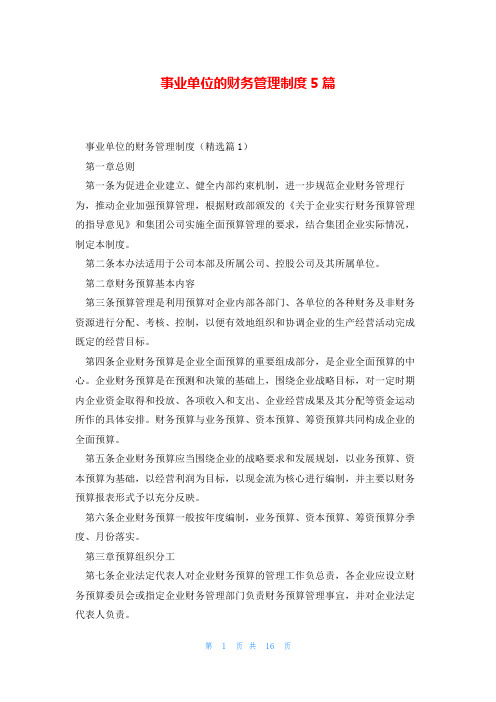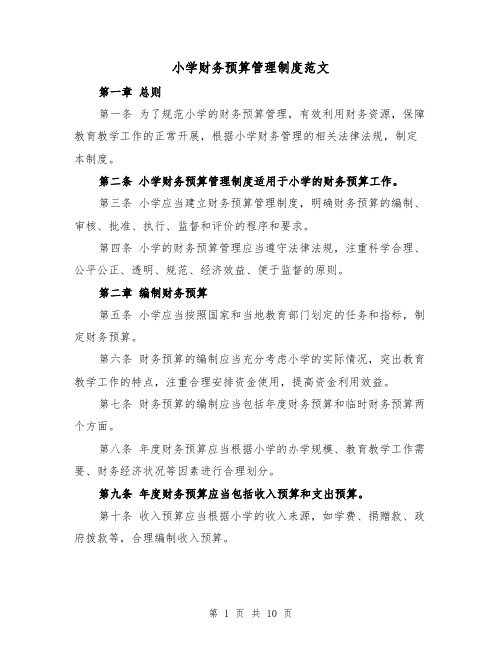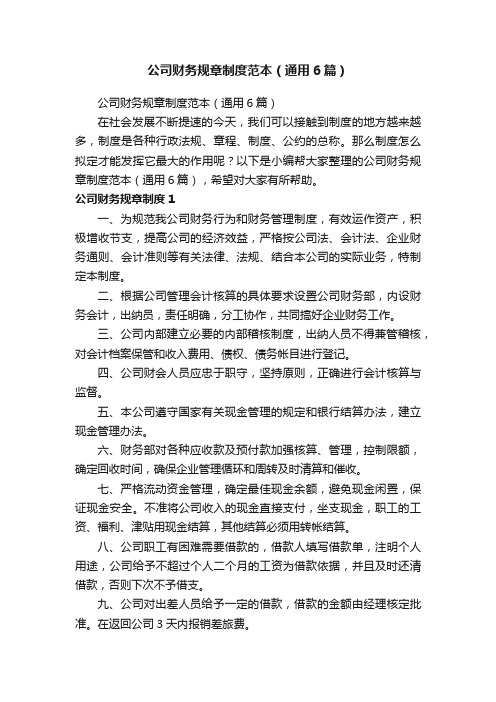第二十七章短期财务与计划
财政部关于颁发《工业企业财务制度》的通知-[92]财工字第574号
![财政部关于颁发《工业企业财务制度》的通知-[92]财工字第574号](https://img.taocdn.com/s3/m/c55b6ace185f312b3169a45177232f60ddcce731.png)
财政部关于颁发《工业企业财务制度》的通知正文:---------------------------------------------------------------------------------------------------------------------------------------------------- 财政部关于颁发《工业企业财务制度》的通知((92)财工字第574号)国务院各部委、各直属机构,各省、自治区、直辖市、计划单列市财政厅(局):为了规范企业财务行为,加强财务管理和经济核算,根据《企业财务通则》,制订了《工业企业财务制度》,现予颁发,自一九九三年七月一日起施行。
执行中有何问题,望及时函告我们。
中华人民共和国财政部一九九二年十二月三十日工业企业财务制度第一章总则第一条为了规范工业企业财务行为,有利于企业公平竞争,加强财务管理和经济核算,根据《企业财务通则》,制定本制度。
第二条本制度适用于中华人民共和国境内的各类工业企业(以下简称企业),包括:全民所有制企业、集体所有制企业、私营企业、外商投资企业等各类经济性质的企业;有限责任公司、股份有限公司等各类组织形式的企业。
非工业系统独立核算的工业企业也适用本制度。
第三条企业应当在办理工商登记之日起30日内,向主管财政机关提交企业设立企业批准证书、营业执照、合同、章程等文件的复印件。
企业发生迁移、合并、分立以及其他变更登记等主要事项,应当在依法办理变更登记之日起30日内,向主管财政机关提交变更文件的复印件。
第四条企业应当建立健全财务管理制度,完善内部经济责任制,严格执行国家规定的各项财务开支范围和标准,如实反映企业财务状况和经营成果,依法计算缴纳国家税收,并接受主管财政机关检查监督。
第五条企业财务管理的基本任务和方法是,做好各项财务收支的计划、控制、核算、分析和考核工作,依法合理筹集资金,有效利用企业各项资产,努力提高经济效益。
财务科工作管理制度

第一章总则第一条为加强公司财务管理工作,规范财务科工作流程,提高财务管理水平,保障公司财务安全,根据《中华人民共和国公司法》、《中华人民共和国会计法》等相关法律法规,结合公司实际情况,特制定本制度。
第二条本制度适用于公司财务科全体工作人员。
第三条财务科工作应遵循以下原则:1. 依法合规:严格按照国家法律法规和政策规定,规范财务行为。
2. 实事求是:真实、准确、完整地反映公司财务状况。
3. 严谨细致:严谨操作,细致管理,确保财务工作质量。
4. 保密原则:严格保守公司商业秘密,不得泄露公司财务信息。
第二章职责分工第四条财务科长:1. 负责全面领导财务科工作,制定财务管理制度,组织实施。
2. 负责协调各部门之间的财务关系,确保财务工作顺利进行。
3. 负责对财务报表进行审核,确保报表真实、准确、完整。
4. 负责组织财务人员进行业务培训,提高财务人员业务素质。
5. 负责对财务工作进行监督,确保财务工作符合国家法律法规和政策规定。
第五条财务主管:1. 负责协助财务科长管理财务科工作,组织实施财务管理制度。
2. 负责审核财务报表,确保报表真实、准确、完整。
3. 负责对财务人员进行业务指导,提高财务人员业务素质。
4. 负责监督财务人员的工作,确保财务工作符合国家法律法规和政策规定。
第六条财务人员:1. 负责具体执行财务管理制度,办理财务业务。
2. 负责收集、整理、归档财务资料,确保资料完整、准确。
3. 负责对财务数据进行统计分析,为领导决策提供依据。
4. 负责配合内部审计和外部审计工作。
第三章工作流程第七条财务预算管理:1. 制定年度财务预算,报公司领导审批。
2. 实施预算管理,对预算执行情况进行跟踪、分析、调整。
3. 年度结束后,对预算执行情况进行总结、评估。
第八条资金管理:1. 负责公司资金收支管理,确保资金安全。
2. 负责办理银行开户、销户、资金调拨等业务。
3. 负责编制资金计划,确保资金合理使用。
第九条会计核算:1. 负责编制会计凭证,确保凭证真实、合法、完整。
财务管理制度制度

第一章总则第一条为了加强本单位的财务管理,规范财务行为,提高资金使用效率,保障资金安全,根据国家有关法律法规和财务管理制度,结合本单位实际情况,制定本制度。
第二条本制度适用于本单位所有财务活动,包括预算管理、收入管理、支出管理、资产管理、负债管理、成本费用管理、内部审计等方面。
第三条本单位财务管理遵循以下原则:(一)合法性原则:遵守国家法律法规,严格执行财务政策;(二)真实性原则:财务数据真实、准确、完整;(三)及时性原则:及时反映财务状况和经营成果;(四)效益性原则:提高资金使用效率,降低成本,实现经济效益最大化;(五)安全性原则:确保资金安全,防范财务风险。
第二章预算管理第四条本单位实行预算管理,预算包括年度预算和月度预算。
第五条年度预算由各部门根据单位发展规划和业务需求编制,经财务部门审核后,报单位领导审批。
第六条月度预算根据年度预算和实际情况进行调整,由财务部门审核后,报单位领导审批。
第七条预算执行过程中,如遇特殊情况需要调整预算,需经单位领导审批。
第八条财务部门负责预算的执行、监督和调整,确保预算目标的实现。
第三章收入管理第九条本单位收入包括政府拨款、经营收入、捐赠收入等。
第十条各收入来源的确认、核算和入账,严格按照国家相关规定执行。
第十一条收入入账后,及时编制收入报表,报单位领导审批。
第十二条财务部门负责收入的管理和监督,确保收入的真实性和合法性。
第四章支出管理第十三条本单位支出包括日常支出、资本性支出、专项支出等。
第十四条各支出项目的申请、审批、报销和支付,严格按照国家相关规定和本单位财务制度执行。
第十五条日常支出实行定额管理,超定额支出需经单位领导审批。
第十六条资本性支出和专项支出,按照预算执行,确保资金合理使用。
第十七条财务部门负责支出管理,加强支出监督,防止浪费和违规支出。
第五章资产管理第十八条本单位资产包括固定资产、流动资产、无形资产等。
第十九条资产的购置、使用、处置,严格按照国家相关规定和本单位财务制度执行。
行政事业单位财务管理规定

行政事业单位财务管理制度第一章第一条为了进一步加强行政事业单位财务管理,健全财务制度,杜绝违纪违法行为,从源头上预防腐败,促进党风廉政建设和我市经济有序健康发展,根据中华人民共和国预算法、中华人民共和国会计法、中华人民共和国政府采购法和财政部行政单位财务规则、事业单位财务规则等有关法律、法规规定,并结合我市实际制定本规定.第二条行政事业单位财务管理,是单位管理的重要组成部分,是规范单位经济活动和社会经济秩序的重要手段.行政事业单位的财务管理必须符合国家有关法律、法规和财务规章制度.行政事业单位应建立健全单位各项财务管理制度,完善内部监控制度,防止财产、资金流失、浪费或被贪污、挪用.第三条行政事业单位的财务管理包括:预算管理、收入管理、支出管理、采购管理、资产管理、往来资金结算管理、现金及银行存款管理、财务监督和财务机构等项管理.第四条财政部门负责行政事业单位财务管理工作.审计、税务、物价、监察、人民银行等有关部门应当依据各自职责做好行政事业单位财务监督工作.第二章预算管理第五条行政事业单位应当按照规定编制年度部门预算,报同级财政部门按法定程序审核、报批.部门预算由收入预算、支出预算组成.第六条行政事业单位依法取得的各项收入,包括:行政事业性收费、罚款和罚没收入、上级补助收入、附属单位上缴收入、捐赠、其他收入等必须列入收入预算,不得隐瞒或少列.行政事业单位取得的各项收入包括实物,要据实及时入账,不得隐瞒,更不得另设账户或私设“小金库”.按规定纳入财政专户或财政预算内管理的预算外资金或罚没款,要按规定实行收支两条线管理,并及时缴入国库或财政专户,不得滞留在单位坐支、挪用.第七条行政事业单位编制的支出预算,应当保证本部门履行基本职能所需要的人员经费和公用经费,对其他弹性支出和专项支出应当严格控制.支出预算包括:人员支出、日常公用支出、对个人和家庭的补助支出、专项支出.人员支出预算的编制必须严格按照国家政策规定和标准,逐项核定,没有政策规定的项目,不得列入预算.日常公用支出预算的编制应本着节约、从俭的原则编报.对个人和家庭的补助支出预算的编制应严格按照国家政策规定和标准,逐项核定.专项支出预算的编制应紧密结合单位当年主要职责任务、工作目标及事业发展设想,并充分考虑财政的承受能力,本着实事求是:从严从紧、区别轻重缓急,急事优先的原则按序安排支出事项.第八条对财政下达的预算,单位应结合工作实际制定用款计划和项目支出计划.预算一经确立和批复,原则上不予调整和追加.第九条行政事业单位应加强对本级财政预算安排的项目资金和上级补助资金的管理,建立健全项目的申报、论证、实施、评审及验收制度,保证项目的顺利实施.专.项资金应实行项目管理,专款专用,不得虚列项目辜出,不得截留、挤占、挪用、浪费、套取、转移专项资金,不得进行二次分配.单位应建立专项资金绩效考核评价制度,提高资金使用效益.第十条行政事业单位应建立健全支出内部控制制度和内部稽核、审批、审查制度,完善内部支出管理,强化内部约束,不断降低行政事业单位运行成本.各项支出应当符合国家的现行规定,不得擅自提高补贴标准,不得巧立名目、变相扩大个人补贴范围;不得随意提高差旅费、会议费等报销标准;不得追求奢华超财力购臵或配备高档交通工具、办公设备和其他设施.第三章采购管理第十一条行政事业单位的货物购臵、工程含维修和服务项目,应当按照规定实行政府采购.第十二条采购代理机构进行政府采购活动,应当符合采购价格低于市场平均价格、采购效率更高、采购质量优良和服务良好的要求.第十三条行政事业单位、采购代理机构及其他工作人员在政府采购工作中不得有下列行为:1、擅自提高政府采购标准:2、以不合理的条件对供应商实行差别待遇或者歧视待遇;3、在招标采购过程中与投标人进行协商谈判;4、中标、成交通知书发出后不与中标、成交供应商签订采购合同:5、与供应商恶意串通:6、在采购过程中接受贿赂或者获取其他不正当利益;7、开标前泄露标底:8、隐匿、销毁应当保存的采购文件,或者伪造、变造采购文件;9、其他违反政府采购规定的行为.第四章结算管理第十四条行政事业单位开立银行结算账户,应经同级财政部门同意后,按照人民币银行结算账户管理规定到银行办理开户手续.第十五条行政事业单位不得有下列违反人民币银行结算账户管理规定的行为:1、擅自多头开设银行结算账户:2、将单位款项以个人名义在金融机构存储;3、出租、出借银行账户.第十六条行政事业单位对外支付的劳务费、购臵费、工程款、暂预付款等,应当符合人民币银行结算账户管理办法和现金管理暂行条例的规定,要求实行银行转账、汇兑、托收等形式结算的,不得以大额现金支付.第十七条行政事业单位应加强银行存款和现金的管理,单位取得的各项货币收入应及时入账,并按规定及时转存开户银行账户,超过库存限额的现金应及时存入银行.银行存款和现金应由单位专人负责登记“银行存款日记账”、“现金日记账”,并定期与单位“总分类账”核对余额,确保资金完整.“银行存款日记账”、“现金日记账,,与“总分类账”应分别由单位出纳、会计管理和登记,不得由一人兼管.第十八条单位资金不允许公款私存或以存折储蓄方式管理.第十九条行政事业单位应切实加强往来资金的管理.借入资金、暂收、暂存、代收、代扣、代缴款项应及时核对、清理、清算、解交,避免跨年度结算或长期挂帐,影响资金的合理流转.预暂付、个人因公临时借款等都应及时核对、清理,在规定的期限内报账、销账、缴回余款,避免跨年度结算或长期挂帐.严禁公款私借,严禁以各种理由套取大额现金长期占用不报账、销账、缴回余款,逃避监管.第二十条行政事业单位应建立和完善授权审批制度.资金划转、结算支付事项应明确责任、划分权限实行分档审批重大资金划转、结算支付事项,应通过领导集体研究决定,避免资金管理权限过于集中,单位的一切资金划转、结算支付事项由一个人说了算的“家长式”管理模式.第五章资产管理第二十一条资产是指行政事业单位占有或使用的能以货.币计量的经济资源,包括流动资产含:现金、各种存款、往来款项、材料、燃料、包装物和低值易耗品等、固定资产、无形资产和对外投资等.行政事业单位必须依法管理使用国有资产,要完善资产管理制度,维护资产的安全和完整,提高资产使用效益.第二十二条行政事业单位应加强对材料、燃料、包装物和低值易耗品的管理,建立、健全其内部购臵、保管、领用等项管理制度,对存货进行定期或者不定期的清查盘点,保证账实相符.第二十三条行政事业单位固定资产应实行分类管理.固定资产一般可划分为房屋和建筑物、专用设备、一般设备、文物和陈列品、图书、其他固定资产等类型.单位应按照固定资产的固定性、移动性等特点,制定各类固定资产管理制度,进行明细核算,不得隐匿、截留、挪用固定资产.单位应建立固定资产实物登记卡,详细记载固定资产的购建、使用、出租、投资、调拨、出让、报废、维修等情况,明确保管使用人的责任,保证固定资产完整,防止固定资产流失.第二十四条行政事业单位固定资产不允许公物私用或无偿交由与单位无关的经营单位使用.第二十五条行政事业单位不得随意处臵固定资产.固定资产的调拨、捐赠、报废、变卖、转让等,应当经过中介机构评估或鉴定,报主管部门和财政部门批准.固定资产的变价收入应当转入修购基金,用于固定资产的更新.第二十六条行政事业单位在维持本单位事业正常发展的前提下,按照国家有关政策规定,将非经营性资产转为经营性资产投资的,应当进行申报和评估,并报经主管部门审核后报财政部门批准.投资取得的各项收入全部纳入单位预算管理.任何单位不得将国家财政拨款、上级补助和维持事业正常发展的资产转作经营性使用.第二十七条行政事业单位应当定期或者不定期的对资产进行账务清理、对实物进行清查盘点.年度终了前应当进行一次全面清查盘点.第二十八条行政事业单位因机构改革或其他原因发生划转、撤销或合并时,应当对单位资产进行清算.清算工作应当在主管部门、财政部门、审计部门的监督指导下,对单位的财产、债权、债务等进行全面清理,编制财产目录和债权、债务清单,提出财产作价依据和债权、债务处理办法,做好国有资产的移交、接收、调拨、划转和管理工作,防止国有资产流失.第六章财务机构第二十九条行政事业单位按照规定设臵财务会计机构、配备会计人员,负责对本单位的经济活动进行统一管理和核算.单位内部的其他非独立工作部门或机构不得脱离单位统一监督另设会计、出纳,不得另立账户从事会计核算.从事会计工作的人员,必须取得会计从业资格证书.第三十条单位会计机构中的会计、出纳人员,必须分设,银行印鉴必须分管.不得以任何理由发生会计、出纳一人兼,银行印鉴一人管的现象.第三十一条行政事业单位按照规定设臵会计账簿,根据实际发生的业务事项进行会计核算,填制会计凭证,登记会计账簿,编制财务会计报告.行政事业单位负责人对本单位的财务会计工作和会计资料的真实性、完整性依法负责.第三十二条会计委派制度和会计集中核算,是加强会计监督和财务管理的有效形式,是从源头上防范和治理腐败的重要措施.会计集中核算机构应按照本规定进一步完善核算制度,加强资金管理.纳入会计集中核算机构管理的单位,要按照市级行政事业单位会计集中核算实施办法,明确职责、履行义务,进一步完善管理,加强对单位收入、支出、资金拨付和资产的管理,防止国家资产、资金流失和浪费.第三十三条行政事业单位不得有下列违反会计管理规定的行为:1、授意、指使、强令会计机构、会计人员伪造、变造会计凭证、会计账簿和其他会计资料,提供虚假财务会计报告;向不同的会计资料使用者提供编制依据不一致的财务会计报告;2、明知是虚假会计资料仍授意、指使、强令会计机构、会计人员报销支出事项,提供虚假会计记录和其他会计资料;3、另立账户,私设会计账簿,转移资金;4、未按照规定填制、取得原始凭证或者填制、取得原始凭证不符合规定;5、以未经审核的会计凭证为依据登记会计账簿或者登记会计账簿不符合规定;6、随意变更会计处理方法;7、未按照规定建立并实施单位内部会计监督制度;8、拒绝依法实施的监督或者不如实提供有关会计信息资料;9、隐匿或者故意销毁依法应当保存的会计凭证、会计账簿、财务会计信息资料;10、随意将财政性资金出借他人,为小团体或个人牟取利益;11、其他违反会计管理规定的行为.第三十四条财务会计人员工作调动或者离职,必须与接管人员办理交接手续,在交接手续未办清以前不得调动或离职.财务会计机构负责人和财会主管人员办理交接手续,由单位负责人监交,必要时上级单位可派人会同监交.一般财务会计人员办理交接手续,可由财务会计机构负责人监交.财务会计人员短期离职,应由单位负责人指定专人临时接替.第七章财务监督第三十五条行政事业单位应依据会计法、会计基础工作规范等法规建立健全财务、会计监督体系,.单位负责人对财务、会计监督工作负领导责任.会计机构、会计人员对本单位的经济活动依法进行财务监督.第三十六条行政事业单位财务监督是指单位根据国家有关、雄律、法规和财务规章制度,对本单位及下级单位的财务活动进行审核、检查的行为.内容一般包括:预算的编制和执行、收入和支出的范围及标准、专用基金的提取和使用、资产管理措施落实、往来款项的发生和清算、财务会计报告真实性、准确性、完整性等.第三十七条预算编制和执行的监督.行政事业单位应建立健全预算编制、申报、审查程序.单位预算的编制应当符合党和国家的方针、政策、规章制度和单位事业的发展计划,应当坚持“量入为出、量力而行、有保有压、收支平衡”的原则.单位对各项支出是否真实可靠,各项收入是否全部纳入预算,有无漏编、重编,预算是否严格按照批准的项目执行,有无随意调整预算或变更项目等行为事项进行监督.第三十八条单位收入的监督.收入是指行政事业单位依法取得的非偿还性资金,包括财政预算拨款收入,预算外资金收入以及其他合法收入.这部分资金涉及政策性强,应加强监督,其监督的主要内容是:1、单位的收入是否全部纳入单位预算,统一核算、统一管理.2、是否依法积极组织收入;各项收费是否符合国家的收费政策和管理制度:是否做到应收尽收,有无超收乱收的情况.3、对于按规定应上缴国家的收入和纳入财政专户管理的资金,是否及时、足额上缴,有无拖欠、挪用、截留坐支等情况.4、单位预算外收入与经营收入是否划清,对经营、服务性收入是否按规定依法纳税.第三十九条单位支出的监督.支出是指行政事业单位为开展业务活动所发生的资金耗费.支出管理是行政事业单位财务管理和监督的重点.其监督的主要内容是:1、各项支出是否精打细算,厉行节约、讲求经济、实效、有无进一步压缩的可能.2、各项支出是否按照国家规定的用途、开支范围、开支标准使用;支出结构是否合理,有无互相攀比、违反规定超额、超标准开会、配备豪华交通工具、办公设备及其他设施.3、基建或项目支出与行政事业经费支出的界限是否划清,有无基建或项目支出挤占单位经费,或单位经费有无列入基建或项目支出的现象.应由个人负担的支出,有无由单位经费负担的现象.是否划清单位经费支出与经营支出的界限,有无将应由经费列支的项目列入经营支出或将经营支出项目列入单位经费支出的现象.4、事业单位专用基金的提取,是否依据国家统一规定或财政部门规定执行;各项专用基金是否按照规定的用途和范围使用.第四十条资产监督即对资产管理要求和措施的落实情况进行的检查督促,包括:1、是否按国家规定的现金使用范围使用现金;库存现金是否超过限额,有无随意借支、非法挪用、白条抵库的现象;有无违反现金管理规定,坐支现金、私设小金库的情况.2、各种应收及预付款项是否及时清理、结算;有无本单位资金被其他单位长期大量占用的现象.3、对各项负债是否及时组织清理,按时进行结算,有无本单位无故拖欠外单位资金的现象,应缴款项是否按国家规定及时、足额地上缴,有无故意拖欠、截留和坐支的现象.4、各项存货是否完整无缺,各种材料有无超定额储备、积压浪费的现象;存货和固定资产的购进、验收、入库、领发、登记手续是否齐全,制度是否健全,有无管理不善、使用不当、大材小用、公物私用、损失浪费,甚至被盗的情况.5、存货和固定资产是否做到账账相符、账实相符;是否存在有账无物、有物无账等问题;固定资产有无长期闲臵形成浪费问题;有无未按规定报废、转让单位资产的问题发生.6、对外投资是否符合国家有关政策;有无对外投资影响到本单位完成正常的事业计划的现象:以实物无形资产对外投资时,评估的价值是否正确.第四十一条行政事业单位应建立健全内部监控、财务公示等制度,应确定专门机构或专兼职人员对发生的经济事项进行事前、事中、事后监督、审查.单位的财务执行情况,应在一定的范围、时期内公示,接受群众监督.第四十二条行政事业单位应自觉接受审计、财政部门的检查和监督.第四十三条行政事业单位领导工作调动或者离职,必须经同级审计部门进行任期离任审计.第八章附则第四十四条本规定适用于市级行政事业单位.行政事业单位基本建设投资的财务管理,除国家另有规定外应当参照本规定办理.第四十五条本规定由市财政局负责解释.第四十六条本规定自发文之日起施行.。
财务会计管理制度范文(三篇)

财务会计管理制度范文第一章总则第一条为了规范和提高企业的财务会计管理水平,确保财务会计信息的真实、准确、完整和及时性,保护和增值企业的财务资产,制定本制度。
第二条本制度适用于企业的财务会计管理活动,包括财务会计记录和报告、会计政策和准则、财务分析和决策等。
第三条企业的财务会计管理应遵循以下原则:(一)真实性原则:财务会计信息应真实、客观地反映企业的经济业务活动。
(二)完整性原则:财务会计信息应包括企业所有的经济业务活动,并准确地进行记录和报告。
(三)准确性原则:财务会计信息应准确地反映企业的经济实际状况和经营成果。
(四)及时性原则:财务会计信息应及时地进行记录和报告,确保用户对企业的财务状况和经营成果的了解。
(五)可比性原则:财务会计信息应具有可比性,便于用户比较不同期间和不同企业的财务状况和经营成果。
第四条企业应建立健全财务会计管理制度,明确财务会计管理的职责、权限和程序,确保财务会计信息的准确性和可靠性。
第五条企业应按照国家的法律法规和财务会计准则的要求进行财务会计管理,不得违反国家的法律法规和财务会计准则。
第六条财务会计管理制度的制定、修改和废止,应经企业法定代表人或授权的机关批准。
第七条企业应制定相应的财务会计管理规程和操作规范,明确操作流程和责任分工,确保财务会计管理的规范和有效。
第二章财务会计记录和报告第八条企业应按照财务会计准则的要求,建立健全财务会计账簿和档案,准确地记录和保存企业的经济业务活动。
第九条企业应及时进行财务会计记录,确保财务会计信息的真实、准确和完整。
第十条企业应按照财务会计准则的要求,编制财务会计报表,准确地反映企业的财务状况、经营成果和现金流量。
第十一条企业应按照财务会计准则的要求,定期进行财务会计核算和分析,评估企业的经营状况和经营效益。
第十二条企业应按照财务会计准则的要求,编制年度财务会计报告,报送主管部门和股东,公开发布企业的财务状况和经营成果。
第三章会计政策和准则第十三条企业应按照财务会计准则的要求,确定会计政策和准则,明确会计核算方法和处理原则。
闲置资金理财财务制度规定

闲置资金理财财务制度规定第一章总则第一条为规范公司闲置资金的管理和运用,合理配置资金资源,提高资金使用效率,根据国家相关政策及公司实际情况,制定本制度。
第二条闲置资金是指公司未投入经营和生产活动,或者用于其它特定用途而暂时闲置在银行、货币市场基金、债券等金融工具的资金。
第三条公司应当建立健全闲置资金的管理制度,明确闲置资金的来源、管理责任、使用范围和方式,保障资金的安全、流动性和收益性。
第四条公司应当根据自身业务发展和资金需求情况,制定合理的闲置资金使用计划,避免资金长期闲置或被挪用。
第五条公司应当加强对闲置资金的监督检查,防范资金风险,保障公司利益。
第六条公司应当建立健全闲置资金使用审批制度,确保资金使用合法合规。
第七条公司应当加强与金融机构的合作,优化闲置资金的配置,提高资金使用效益。
第八条公司应当定期对闲置资金进行跟踪管理和分析,及时调整投资组合,优化资金运作方式。
第九条公司应当加强内部员工对闲置资金管理的培训和教育,提高员工的风险意识和理财能力。
第十条公司应当建立完善的闲置资金管理制度档案,保证资金管理工作的连续性和稳定性。
第十一条公司应当充分发挥财务部门的作用,加强与各部门的协调配合,确保闲置资金的安全和有效利用。
第十二条公司应当根据需要组织相关部门和人员对闲置资金的管理工作进行评估和审计,发现问题及时整改。
第十三条公司应当建立健全的风险管理机制,加强对闲置资金的风险评估和监控,防范各类金融风险。
第十四条对于特定的闲置资金项目,公司应当建立相应的专门管理机构,加强监督和控制。
第十五条公司应当建立完善的内部控制制度,加强对闲置资金的使用和流动的监督和审计。
第十六条公司应当加强对闲置资金的外部环境监测和分析,及时调整投资策略,降低风险。
第十七条公司应当积极响应国家政策,支持实体经济发展,推动闲置资金向实体经济领域倾斜。
第十八条公司应当建立健全的信息披露制度,及时向社会公开闲置资金管理的相关信息。
个体户财务管理制度(3篇)

第1篇第一章总则第一条为了规范个体户的财务管理,加强财务监督,保障个体户合法权益,促进个体户健康发展,根据《中华人民共和国会计法》、《个体工商户条例》等法律法规,结合个体户实际情况,制定本制度。
第二条本制度适用于从事合法经营的个体工商户(以下简称“个体户”),包括但不限于个体工商户、个人独资企业、合伙企业等。
第三条个体户财务管理应当遵循以下原则:(一)合法性原则:遵守国家法律法规,严格执行财务制度;(二)真实性原则:如实记录、反映个体户的经济业务;(三)完整性原则:确保财务信息的全面、准确;(四)及时性原则:及时处理财务事项,确保财务信息的时效性;(五)效益性原则:合理运用财务资源,提高经济效益。
第二章财务核算第四条个体户应当设置会计账簿,按照国家统一的会计制度进行会计核算。
第五条个体户的会计账簿应当包括以下内容:(一)总账:记录个体户的全部经济业务;(二)明细账:按科目、按时间、按项目详细记录各项经济业务;(三)日记账:记录个体户日常发生的经济业务;(四)辅助账:根据需要设置的账簿,如现金账、应收账款账等。
第六条个体户应当使用合法的会计凭证,包括原始凭证和记账凭证。
第七条个体户应当建立健全凭证审核制度,确保凭证的真实性、合法性、完整性。
第八条个体户的会计凭证应当妥善保管,保存期限不少于五年。
第九条个体户应当定期进行财务报表编制,包括资产负债表、利润表、现金流量表等。
第十条个体户的财务报表应当真实、准确、完整地反映个体户的财务状况和经营成果。
第三章资产管理第十一条个体户的资产包括流动资产、固定资产、无形资产等。
第十二条个体户应当建立健全资产管理制度,确保资产的安全、完整和有效利用。
第十三条个体户的流动资产包括现金、银行存款、应收账款、存货等。
第十四条个体户应当对现金和银行存款实行严格的收支管理,确保资金的安全。
第十五条个体户应当建立健全应收账款管理制度,及时催收欠款,降低坏账风险。
第十六条个体户的存货管理应当遵循以下原则:(一)合理采购原则:根据经营需要合理采购存货;(二)库存控制原则:合理控制库存,避免积压和短缺;(三)损耗控制原则:采取措施降低存货损耗。
公司财务规章制度(精选5篇)

公司财务规章制度(精选5篇)公司财务规章制度1第一章总则第一条爲加强财务管理,规范财务工作,促进公司经营业务的发展,提高公司经济效益,根据国家有关财务管理法规制度和公司章程有关规定,结合公司实际情况,特制定本制度。
第二条公司会计核算遵循权责发生制原则。
第三条财务管理的基本任务和方法:(一)筹集资金和有效使用资金,监督资金正常运行,维护资金安全,努力提高公司经济效益。
(二)做好财务管理基础工作,建立健全财务管理制度,认真做好财务收支的计划、控制、核算、分析和考核工作。
(三)加强财务核算的管理,以提高会计资讯的及时性和准确性。
(四)监督公司财産的购建、保管和使用,配合综合管理部定期进行财産清查。
(五)按期编制各类会计报表和财务说明书,做好分析、考核工作。
第四条财务管理是公司经营管理的一个重要方面,公司财务管理中心对财务管理工作负有组织、实施、检查的责任,财会人员要认真执行《会计法》,坚决按财务制度办事,并严守公司秘密。
第二章财务管理的基础工作第五条加强原始凭证管理,做到制度化、规范化。
原始凭证是公司发生的每项经营活动不可缺少的书面证明,是会计记录的主要依据。
第六条公司应根据审核无误的原始凭证编制记帐凭证。
记帐凭证的内容必须具备:填制凭证的日期、凭证编号、经济业务摘要、会计科目、金额、所附原始凭证张数、填制凭证人员,复核人员、会计主管人员签名或盖章。
收款和付款记帐凭证还应当由出纳人员签名或盖章。
第七条健全会计核算,按照国家统一会计制度的规定和会计业务的需要设置会计帐簿。
会计核算应以实际发生的经济业务爲依据,按照规定的会计处理方法进行,保证会计指标的口径一致,相互可比和会计处理方法前後相一致。
第八条做好会计审核工作,经办财会人员应认真审核每项业务的合法性、真实性、手续完整性和资料的准确性。
编制会计凭证、报表时应经专人复核,重大事项应由财务负责人复核。
第九条会计人员根据不同的帐务内容采用定期对会计帐簿记录的有关数位与库存实物、货币资金、有价证券、往来单位或个人等进行相互核对,保证帐证相符、帐实相符、帐表相符。
事业单位的财务管理制度5篇

事业单位的财务管理制度5篇事业单位的财务管理制度(精选篇1)第一章总则第一条为促进企业建立、健全内部约束机制,进一步规范企业财务管理行为,推动企业加强预算管理,根据财政部颁发的《关于企业实行财务预算管理的指导意见》和集团公司实施全面预算管理的要求,结合集团企业实际情况,制定本制度。
第二条本办法适用于公司本部及所属公司、控股公司及其所属单位。
第二章财务预算基本内容第三条预算管理是利用预算对企业内部各部门、各单位的各种财务及非财务资源进行分配、考核、控制,以便有效地组织和协调企业的生产经营活动完成既定的经营目标。
第四条企业财务预算是企业全面预算的重要组成部分,是企业全面预算的中心。
企业财务预算是在预测和决策的基础上,围绕企业战略目标,对一定时期内企业资金取得和投放、各项收入和支出、企业经营成果及其分配等资金运动所作的具体安排。
财务预算与业务预算、资本预算、筹资预算共同构成企业的全面预算。
第五条企业财务预算应当围绕企业的战略要求和发展规划,以业务预算、资本预算为基础,以经营利润为目标,以现金流为核心进行编制,并主要以财务预算报表形式予以充分反映。
第六条企业财务预算一般按年度编制,业务预算、资本预算、筹资预算分季度、月份落实。
第三章预算组织分工第七条企业法定代表人对企业财务预算的管理工作负总责,各企业应设立财务预算委员会或指定企业财务管理部门负责财务预算管理事宜,并对企业法定代表人负责。
第八条财务预算委员会主要拟订财务预算的目标、政策,制定财务预算管理的具体措施和办法,审议、平衡财务预算方案,组织下达财务预算,协调解决财务预算编制和执行中的问题,组织审计、考核财务预算的执行情况,督促企业完成财务预算目标。
第九条财务预算编制在企业财务预算管理委员会领导下进行,企业财务管理部门具体负责组织编制、审查、汇总、上报、下达;负责预算执行和日常流程控制;负责预算执行情况的分析和报告;负责预算执行情况考核等。
第十条企业内部生产、投资、物资、人力资源、市场营销等职能部门具体负责本部门业务涉及的财务预算的编制、执行、分析、控制等工作,并配合财务预算委员会做好企业总预算的综合平衡、协调、分析、控制、考核等工作。
小学财务预算管理制度范文(4篇)

小学财务预算管理制度范文第一章总则第一条为了规范小学的财务预算管理,有效利用财务资源,保障教育教学工作的正常开展,根据小学财务管理的相关法律法规,制定本制度。
第二条小学财务预算管理制度适用于小学的财务预算工作。
第三条小学应当建立财务预算管理制度,明确财务预算的编制、审核、批准、执行、监督和评价的程序和要求。
第四条小学的财务预算管理应当遵守法律法规,注重科学合理、公平公正、透明、规范、经济效益、便于监督的原则。
第二章编制财务预算第五条小学应当按照国家和当地教育部门划定的任务和指标,制定财务预算。
第六条财务预算的编制应当充分考虑小学的实际情况,突出教育教学工作的特点,注重合理安排资金使用,提高资金利用效益。
第七条财务预算的编制应当包括年度财务预算和临时财务预算两个方面。
第八条年度财务预算应当根据小学的办学规模、教育教学工作需要、财务经济状况等因素进行合理划分。
第九条年度财务预算应当包括收入预算和支出预算。
第十条收入预算应当根据小学的收入来源,如学费、捐赠款、政府拨款等,合理编制收入预算。
第十一条支出预算应当根据小学的办学需要,如教职工工资、教学设备购置、办公用品、教育培训经费等,合理编制支出预算。
第十二条临时财务预算应当根据小学的特殊情况,如临时活动经费、突发事件应急经费等,进行调整编制。
第十三条财务预算的编制应当参考历史数据、业务发展计划、政策法规等,进行科学合理的预测和设定。
第三章审核批准财务预算第十四条小学应当在规定的时间内完成财务预算的编制工作,并报经费部门进行审核。
第十五条财务预算的审核应当遵循科学合理、合规合法、真实准确等原则,审查预算的合理性、合法性和可行性。
第十六条财务预算审核通过后,由校长审批批准,并报上级主管部门备案。
第四章财务预算的执行和监督第十七条小学应当组织财务部门按照预算计划,合理安排资金使用,做好预算执行工作。
第十八条财务预算的执行应当按照相关财务制度和管理规定进行,做到公正、公平、规范。
财务管理办法

财务管理办法第一章总则第一条为规范有限公司(下称公司)各级经营者的财务关系和财务行为,明确经济责任,根据《公司法》、《会计法》、《企业财务通则》、《企业会计准则》及《公司章程》,制定本管理办法。
第二条公司及所属分公司执行本办法。
公司控股或参股子公司及受托管理公司可参照执行本办法,也可自行制定办法,报经管理决策机构批准后实行。
第三条公司的一切财务活动须遵守国家财务法规,认真贯彻执行公司章程及本管理办法。
第四条公司总经理授权财务部负责本办法的实施,指导和监督分公司、子公司及受托管理公司财务工作。
第二章财务管理体制第五条公司实行董事会领导下由总经理负责的财务管理体制,董事会、经营管理者各行其权,各负其责。
第六条董事会是公司的最高权力机构,按章程行使下列财务管理职权:1.审议批准公司重大经营方针、发展规划和重大投资计划;2.审议批准公司年度财务预、决算方案;3.审议批准公司利润分配(或弥补亏损)方案;4.审议决定公司增资、撤资、发行债券、股票融资等重大筹资方案;5.决定有关董事、监事的报酬事项;决定公司总经理、副总经理、财务负责人报酬事项;6.由董事会批准的其他财务事项。
第七条董事会授权公司总经理,行使如下财务管理职权:1.制定公司经营方针、发展规划和重大投资计划;2.制定公司年度财务预、决算方案;3.制定公司利润分配方案或弥补亏损方案;4.制定公司增资、撤资、发行债券、股票融资等重大筹资方案;5.董事会授权的其他事项。
第八条总经理负责召集、主持总经理办公会,行使如下权力:1.审定重大财务事项,审批重大支出。
授权公司其他管理人员行使支出审批权限。
2.组织实施财务预算、决算、利润分配或亏损弥补等各项财务方案和投资计划;3.审议批准公司各项财务管理制度;4.配合有关机构依法进行审计、评估、财务监督等工作。
5.董事会授权的其他事项。
第九条在总经理领导下,财务部行使下列职权:1. 负责日常财务管理和经济核算,依法交税,协调对外有关财务事项。
小企业财务会计管理制度

小企业财务会计管理制度•相关推荐小企业财务会计管理制度(通用20篇)在当今社会生活中,我们可以接触到制度的地方越来越多,制度是国家法律、法令、政策的具体化,是人们行动的准则和依据。
那么相关的制度到底是怎么制定的呢?以下是小编收集整理的小企业财务会计管理制度,欢迎大家借鉴与参考,希望对大家有所帮助。
小企业财务会计管理制度篇1第一章总则第一条为了规范小企业会计确认、计量和报告行为,促进小企业可持续发展,发挥小企业在国民经济和社会发展中的重要作用,根据《中华人民共和国会计法》及其他有关法律和法规,制定本准则。
第二条本准则适用于在中华人民共和国境内依法设立的、符合《中小企业划型标准规定》所规定的小型企业标准的企业。
下列三类小企业除外:(一)股票或债券在市场上公开交易的小企业。
(二)金融机构或其他具有金融性质的小企业。
(三)企业集团内的母公司和子公司。
前款所称企业集团、母公司和子公司的定义与《企业会计准则》的规定相同。
第三条符合本准则第二条规定的小企业,可以执行本准则,也可以执行《企业会计准则》。
(一)执行本准则的小企业,发生的交易或者事项本准则未作规范的,可以参照《企业会计准则》中的相关规定进行处理。
(二)执行《企业会计准则》的小企业,不得在执行《企业会计准则》的同时,选择执行本准则的相关规定。
(三)执行本准则的小企业公开发行股票或债券的,应当转为执行《企业会计准则》;因经营规模或企业性质变化导致不符合本准则第二条规定而成为大中型企业或金融企业的,应当从次年 1 月 1 日起转为执行《企业会计准则》。
(四)已执行《企业会计准则》的上市公司、大中型企业和小企业,不得转为执行本准则。
第四条执行本准则的小企业转为执行《企业会计准则》时,应当按照《企业会计准则第38号——首次执行企业会计准则》等相关规定进行会计处理。
第二章资产第五条资产,是指小企业过去的交易或者事项形成的、由小企业拥有或者控制的、预期会给小企业带来经济利益的资源。
27会计概论

第二十七章会计概论一、会计基本概念(三星)(一)会计的概念1. 定义:以货币为主要计量单位,采用专门的技术方法,通过对单位的全部资金运动进行核算和监督的一种经济管理活动。
2. 现代会计的形成:管理会计的产生,标志着现代会计的形成。
3. 分支:以企业会计为核心,分为财务会计和管理会计两大分支【例题-单】(2011)现代会计按照对外提供还是对内提供决策所需信息,分为()两大分支。
A. 成本会计和责任会计B. 财务会计和管理会计C. 外资企业会计和国有企业会计D. 国际会计和国内会计【答案】B【解析】本题考查会计的概念。
现代会计按照对外提供还是对内提供决策所需信息,分为财务会计和管理会计两大分支。
【例题-单】(2010)下列会计活动中,属于财务会计范畴的是()A. 财务报告B. 全面预算C. 责任会计D. 成本控制【答案】A【解析】其他三项属于管理会计的范畴。
【例题-单J (2009)下列会计工作中,属于管理会计范畴的是()A. 进行经营决策分析B. 设置会计科目C. 编制会计报表D. 清查财产【答案】A【解析】管理会计包括预测分析、决策分析、全面预算、成本控制和责任会计等内容。
(二) 会计的基本职能——核算和监督1. 职能:(1) 核算职能:通过确认、计量、记录、报告,从价值量方面反映企业已经发生或完成的客观经济活动情况。
是会计的最基本职能。
会计核算具有完整性、连续性和系统性的特点。
(2) 监督职能:包括事前、事中和事后监督,对单位的货币收支及其经济活动的真实性、完整性、合规性和有效性进行检查与控制。
(3) 现代会计的职能还包括预测、决策、评价等。
2. 关系:不可分割。
会计核算是基本的、首要的、会计核算是会计监督的前提,会计监督是核算的保证。
【例题-单】(2011) 通过确认、计量、记录、报告,运用一定的方法或程序,利用货币形式,从价值量方面反映企业已经发生或完成的客观经济活动情况,为经济管理提供可能的会计信息。
公司财务规章制度范本(通用6篇)

公司财务规章制度范本(通用6篇)公司财务规章制度范本(通用6篇)在社会发展不断提速的今天,我们可以接触到制度的地方越来越多,制度是各种行政法规、章程、制度、公约的总称。
那么制度怎么拟定才能发挥它最大的作用呢?以下是小编帮大家整理的公司财务规章制度范本(通用6篇),希望对大家有所帮助。
公司财务规章制度1一、为规范我公司财务行为和财务管理制度,有效运作资产,积极增收节支,提高公司的经济效益,严格按公司法、会计法、企业财务通则、会计准则等有关法律、法规、结合本公司的实际业务,特制定本制度。
二、根据公司管理会计核算的具体要求设置公司财务部,内设财务会计,出纳员,责任明确,分工协作,共同搞好企业财务工作。
三、公司内部建立必要的内部稽核制度,出纳人员不得兼管稽核,对会计档案保管和收入费用、债权、债务帐目进行登记。
四、公司财会人员应忠于职守,坚持原则,正确进行会计核算与监督。
五、本公司遵守国家有关现金管理的规定和银行结算办法,建立现金管理办法。
六、财务部对各种应收款及预付款加强核算、管理,控制限额,确定回收时间,确保企业管理循环和周转及时清算和催收。
七、严格流动资金管理,确定最佳现金余额,避免现金闲置,保证现金安全。
不准将公司收入的现金直接支付,坐支现金,职工的工资、福利、津贴用现金结算,其他结算必须用转帐结算。
八、公司职工有困难需要借款的,借款人填写借款单,注明个人用途,公司给予不超过个人二个月的工资为借款依据,并且及时还清借款,否则下次不予借支。
九、公司对出差人员给予一定的借款,借款的金额由经理核定批准。
在返回公司3天内报销差旅费。
十、参与制定本公司经营管理财务计划,资金管理,收支计划,分析考核预测经济成果,严格收支范围,认真审核费用支出,凡支出款项必须有经理签字。
十一、公司应定期对会计人员进行岗位培训,财务人员必须每二年培训一次,跟上新形式下财务核算的要求。
市场推广人员薪资标准一。
工作职责在公司指定场所(地铁商铺、商厦、办公楼、卖场等)按照公司市场推广操作流程进行市场推广活动。
企业财务通则-财政部令第4号

企业财务通则正文:---------------------------------------------------------------------------------------------------------------------------------------------------- 企业财务通则(1992年11月16日国务院批准1992年11月30日财政部令第4号发布)第一章总则第一条为了适应我国社会主义市场经济发展的需要,规范企业财务行为,有利于企业公平竞争,加强财务管理和经济核算,制定本通则。
第二条本通则是设立在中华人民共和国境内的各类企业财务活动必须遵循的原则和规范。
第三条企业应当在办理工商登记或者变更登记之日起三十日内,向主管财政机关提交企业设立批准证书、营业执照、章程等文件或者变更文件的复制件。
第四条企业财务管理的基本原则是,建立健全企业内部财务管理制度,做好财务管理基础工作,如实反映企业财务状况,依法计算和缴纳国家税收,保证投资者权益不受侵犯。
第五条企业财务管理的基本任务和方法是,做好各项财务收支的计划、控制、核算、分析和考核工作,依法合理筹集资金,有效利用企业各项资产,努力提高经济效益。
第二章资金筹集第六条设立企业必须有法定的资本金。
资本金是指企业在工商行政管理部门登记的注册资金。
资本金按照投资主体分为国家资本金、法人资本金、个人资本金以及外商资本金等。
第七条企业根据国家法律、法规的规定,可以采取国家投资、各方集资或者发行股票等方式筹集资本金。
投资者可以用现金、实物、无形资产等形式向企业投资。
投资者未按照投资合同、协议履行出资义务的,企业或者其他投资者可以依法追究其违约责任。
第八条企业在筹集资本金活动中,投资者缴付的出资额超出资本金的差额(包括股票溢价),法定财产重估增值,以及接受捐赠的财产等,计入资本公积金。
资本公积金可以按照规定,转增资本金。
第九条企业筹集的资本金,企业依法享有经营权,在企业经营期内,投资者除依法转让外,不得以任何方式抽回。
(完整版)中央企业财务预算管理暂行办法

中央企业财务预算管理暂行办法国务院国有资产监督管理委员会令第18号国资委2007.5.25第一章总则第一条为加强对国务院国有资产监督管理委员会(以下简称国资委)履行出资人职责企业(以下简称企业)的财务监督,规范企业财务预算管理,根据《中华人民共和国公司法》、《企业国有资产监督管理暂行条例》和国家有关财务会计制度规定,制定本办法。
第二条企业年度财务预算编制、报告、执行与监督工作,适用本办法。
第三条本办法所称财务预算是指企业在预测和决策的基础上,围绕战略规划,对预算年度内企业各类经济资源和经营行为合理预计、测算并进行财务控制和监督的活动。
财务预算报告是指反映企业预算年度内企业资本运营、经营效益、现金流量及重要财务事项等预测情况的文件。
第四条企业应当建立财务预算管理制度,组织开展内部财务预算编制、执行、监督和考核工作,完善财务预算工作体系,推进实施全面预算管理。
第五条企业应当在规定的时间内按照国家财务会计制度规定和国资委财务监督工作有关要求,以统一的编制口径、报表格式和编报规范,向国资委报送年度财务预算报告。
第六条国资委依据本办法对企业财务预算编制、报告及执行工作进行监督管理,督促和引导企业切实建立以预算目标为中心的各级责任体系。
第二章工作组织第七条企业应当按照国家有关规定,组织做好财务预算工作,配备相应工作人员,明确职责权限,加强内部协调,完善编制程序和方法,强化执行监督,并积极推行全面预算管理。
第八条企业应当按照加强财务监督和完善内部控制机制的要求,成立预算委员会或设立财务预算领导小组行使预算委员会职责。
在设立董事会的企业中,预算委员会(财务预算领导小组)成员应当有熟悉企业财务会计业务并具备相应组织能力的董事参加。
第九条企业预算委员会(财务预算领导小组)应当履行以下主要职责:(一)拟订企业财务预算编制与管理的原则和目标;(二)审议企业财务预算方案和财务预算调整方案;(三)协调解决企业财务预算编制和执行中的重大问题;(四)根据财务预算执行结果提出考核和奖惩意见。
财务规划中的短期与长期目标

财务规划中的短期与长期目标在财务规划中,设定短期和长期目标是非常重要的。
短期目标通常指一年内要实现的目标,而长期目标则是在多年内实现的目标。
合理设定和达成这些目标,可以帮助我们有效管理财务,实现财务自由和稳定。
一、短期目标的设定短期目标通常是指一年内要达成的目标。
短期目标的设定一般会基于以下几个方面:1. 应急储备:建立紧急备用金是财务规划的重要一环。
这笔资金能够帮助应对紧急情况,如突发疾病、重大家庭事故等。
根据个人情况和家庭支出,合理的储备金额可以是6-12个月的生活费用。
2. 偿还债务:如果存在高息债务,如信用卡债务、个人贷款等,首先要设定偿还债务的目标。
通过制定还款计划,逐步偿还债务,减少利息支出,提高个人信用。
3. 增加收入来源:除了控制开支外,增加收入也是实现短期目标的一种途径。
可以通过提高工资、争取奖金或者增加其他兼职工作等方式来实现增收的目标。
4. 健康与保险:短期目标还应该包括健康和保险方面的考虑。
制定并执行健康计划,如定期体检、健身计划等,有利于预防疾病和确保身体健康。
此外,购买医疗保险、人寿保险等可以有效降低风险,保护家庭财务安全。
二、长期目标的设定长期目标是指在多年内实现的目标,一般是为了实现更高水平的财务自由。
设定和实现长期目标需要全面的规划和策略,以下是几个常见的长期目标:1. 教育基金:如果有子女,设立教育基金是一个重要的长期目标。
通过定期存款或者其他理财手段,为子女的教育提供资金支持。
早期规划教育基金,可以减轻后期的经济压力,确保子女获得良好的教育。
2. 养老基金:为老年生活做好充分的准备也是长期目标之一。
根据个人的情况,制定合理的养老储备计划,选择适合的养老金投资方式,确保晚年生活财务安全。
3. 资产增值:长期目标还包括通过投资或者创业,实现个人财富的增值。
可以考虑投资房地产、股票、基金等,选择适合自己风险承受能力的投资方式,提高财富积累。
4. 慈善捐赠:一些人将慈善捐赠作为长期目标之一。
公司财务会计制度

公司财务会计制度篇一第一章总则一、为了加强经营管理和会计核算工作,根据《中华人民共和国会计法》、《施工企业会计核算办法》、公司章程和总公司财经管理制度及国家其他有关法规的规定,结合本公司经营特点,特制定本制度。
二、本公司设置独立的会计机构,配备必要的会计人员,办理公司的财务会计工作。
三、财务部门要依法合理筹措资金,并有效使用资金。
既要做到广泛筹集资金和组织资金来源,满足工程施工和日常行政办公需要,又要降低筹资成本,有效使用资金,提高资金使用效率。
四、财务管理部门应明确财务会计人员的岗位、职责分明、实行岗位责任制。
五、按照科学管理的要求,建立健全企业内部管理制度和内部财务审批制度,明确内部审批权限,强化内部控制。
企业所有重大财务收支活动,均应实行执行与监督行为相结合。
执行与监督人员相分离的原则,有牵制、有稽核。
对企业资金调度、财务运作和可能对企业财务状况产生影响的经济活动,必须形成由总经理与财务总监实行联合签署方为有效的制度(简称联签制度,下同)凡涉及到重大资金调度、财务运作和可能对企业财务状况产生重大影响的经济活动必须报请董事会批准。
六、凡不符合制度要求,违反财经纪律的各项开支,财会人员必须坚持原则,有权抵制并向总经理与财务总监汇报。
七、正确反映经营成果和财务状况,依法缴纳税收,并接受财税部门和主管部门的检查和监督。
八、财务部门应按照要求认真编制企业各项财务预算,为加快实行全面预算管理办法打下基础。
年度财务预算的编制要体现“真实性、完整性、严肃性、先进性”原则,根据年度预算的目标,分解指标、明确职责、落实责任,并按照分级管理的要求加强检查和考核,以确保财务预算的有效实施。
九、认真做好财务管理的基础工作:(一)做好完整的原始记录,各项经济业务都应及时做好完整的原始记录,确保原始记录的及时、准确、真实。
(二)健全计量验收交接制度,各项财产物资的进出消耗,都要经过严格的计量验收,做到手续齐全,计量准确。
- 1、下载文档前请自行甄别文档内容的完整性,平台不提供额外的编辑、内容补充、找答案等附加服务。
- 2、"仅部分预览"的文档,不可在线预览部分如存在完整性等问题,可反馈申请退款(可完整预览的文档不适用该条件!)。
- 3、如文档侵犯您的权益,请联系客服反馈,我们会尽快为您处理(人工客服工作时间:9:00-18:30)。
Chapter Outline
27.1 Tracing Cash and Net Working Capital 27.2 Defining Cash in Terms of Other Elements 27.3 The Operating Cycle and the Cash Cycle 27.4 Some Aspects of Short-Term Financial Policy 27.5 Cash Budgeting 27.6 The Short-Term Financial Plan 27.7 Summary & Conclusions
=
LongTerm + Debt
Equity
Net Working Capital
=
Cash
–
Other Current Assets
+
Current Liabilities
Long-
Net Working
Cash = Term + Equity – Capital –
Debt
(excluding cash)
McGraw-Hill/Irwin
Copyright © 2002 by The McGraw-Hill Companies, Inc. All rights reserved.
27-4
The Balance-Sheet Model of the Firm
The Net Working Capital Investment Decision
Accounts payable period
Time
Firm receives invoice
Cash paid for materials
Operating cycle
McGraw-Hill/Irwin
Cash cycle
Copyright © 2002 by The McGraw-Hill Companies, Inc. All rights reserved.
Current Assets
Current Liabilities
Long-Term Debt
Fixed Assets 1 Tangible 2 Intangible
McGraw-Hill/Irwin
What longterm investments should the firm engage in?
– Keeping large cash balances and investments in marketable securities.
– Large investments in inventory. – Liberal credit terms.
• A restrictive short-term finance policy would maintain a low ratio of current assets to sales.
Carrying costs
McGraw-Hill/Irwin
Shortage costs
CA*
Investment in
Current Assets ($)
Copyright © 2002 by The McGraw-Hill Companies, Inc. All rights reserved.
• The Sources and Uses of Cash Statement follows from this reasoning.
McGraw-Hill/Irwin
Copyright © 2002 by The McGraw-Hill Companies, Inc. All rights reserved.
McGraw-Hill/Irwin
Copyright © 2002 by The McGraw-Hill Companies, Inc. All rights reserved.
27-2
The Balance-Sheet Model of the Firm
The Capital Budgeting Decision
– Alternative Financing Policies for Current Assets – Usually measured as the proportion of short-term debt to
long-term debt. • Flexible • Restrictive
Fixed Assets
McGraw-Hill/Irwin
Copyright © 2002 by The McGraw-Hill Companies, Inc. All rights reserved.
27-7
27.2 Defining Cash in Terms of Other Elements
Long-
Net Working
Cash = Term + Equity – Capital –
Debt
(excluding cash)
Fixed Assets
• An increase in long-term debt and or equity leads to an increase in cash—as does a decrease in fixed assets or a decrease in the non-cash components of net workinright © 2002 by The McGraw-Hill Companies, Inc. All rights reserved.
27-1
Executive Summary
• We are solidly in to the third great question of corporate finance.
McGraw-Hill/Irwin
Copyright © 2002 by The McGraw-Hill Companies, Inc. All rights reserved.
27-12
Carrying Costs and Shortage Costs
$ Minimum point
Total costs of holding current assets.
Current Assets
Net Working Capital
Current Liabilities
Long-Term Debt
Fixed Assets 1 Tangible 2 Intangible
How much shortterm cash flow does a company need to pay its bills?
Shareholders’ Equity
McGraw-Hill/Irwin
Copyright © 2002 by The McGraw-Hill Companies, Inc. All rights reserved.
27-5
27.1 Tracing Cash and Net Working Capital
27-13
Appropriate Flexible Policy
$
Total costs of holding current
assets.
Minimum
Carrying costs
point
27-9
27.3 The Operating Cycle and the Cash Cycle
Accounts Cash cycle = Operating cycle – payable
period
• In practice, the inventory period, the accounts receivable period, and the accounts payable period are measured by days in inventory, days in receivables and days in payables.
27-8
27.3 The Operating Cycle and the Cash Cycle
Raw material purchased
Order Stock Placed Arrives
Finished goods sold
Cash received
Inventory period
Accounts receivable period
– The Size of the Firm’s Investment in Current Assets – Usually measured relative to the firm’s level of total
operating revenues. • Flexible • Restrictive
McGraw-Hill/Irwin
Copyright © 2002 by The McGraw-Hill Companies, Inc. All rights reserved.
27-11
The Size of the Investment in Current Assets
• A flexible policy short-term finance policy would maintain a high ratio of current assets to sales.
Current Assets
Fixed Assets 1 Tangible 2 Intangible
How can the firm raise the money for the required investments?
